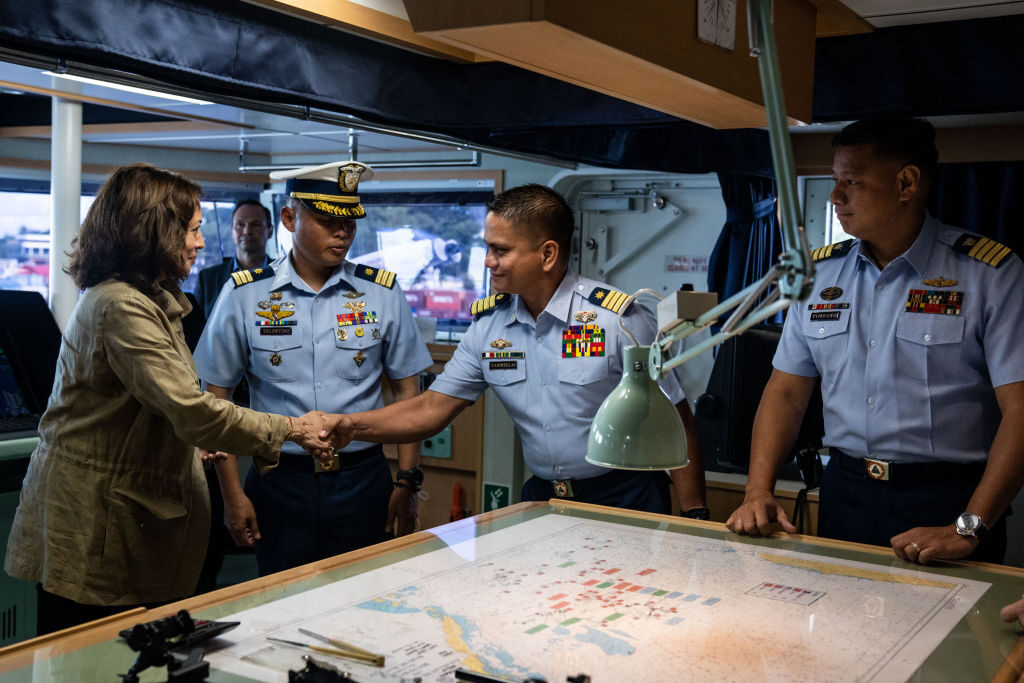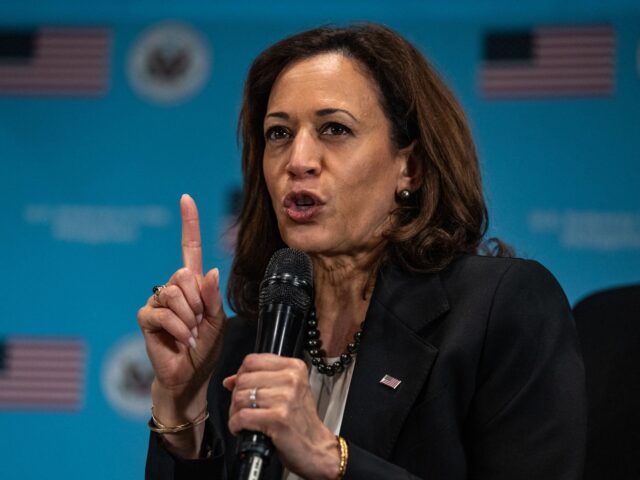Vice President Kamala Harris said during her first official visit to the Philippines on Monday the United States will honor a 1951 bilateral defense treaty and defend Filipino ships against Chinese aggression in the South China Sea.
The issue is pertinent because the Philippines on Monday accused China of using force to retrieve debris from a rocket near the contested Spratly Islands.
“In particular as it relates to the Philippines, I will say that we must reiterate always that we stand with you in defense of international rules and norms as it relates to the South China Sea,” Harris said after meeting with Philippine President Ferdinand Marcos Jr. at Malacanang, the presidential palace in Manila.
“An armed attack on the Philippines, armed forces, public vessels or aircraft in the South China Sea would invoke U.S. Mutual Defense commitments. And that is an unwavering commitment that we have to the Philippines,” Harris said.
Marcos responded that he valued the mutual defense treaty, and hinted at desiring stronger relations with the U.S. than his predecessor.
“I have said many times: I do not see a future for the Philippines that does not include the United States. And that really come from the very long relationship that we have had with the U.S.,” he said.

U.S. Vice-President Kamala Harris tours Philippines Coast Guard ship ‘Teresa Magbanua’ at Puerto Princesa Port, on November 22, 2022. (HAIYUN JIANG/POOL/AFP via Getty Images)
The United States signed a mutual defense treaty with the Philippines in 1951, one of the oldest such treaties still in force in the modern world. The treaty has not done much to dissuade China from constantly bullying the Philippines in disputed waters, perhaps in part because former Philippine President Rodrigo Duterte wanted to distance himself from Washington and curry favor with Beijing.
When the treaty was signed, the Philippines was in the process of building a formidable military, but it rotted away from neglect to a handful of patrol ships. When Philippine officials talked about revising or abandoning the treaty last year, the Chinese reportedly told them to leave it alone, because Beijing reportedly likes the inert agreement just fine the way it is.
On Monday, as Harris arrived in Manila, Vice Admiral Alberto Carlos of the Philippine navy accused a Chinese coast guard vessel of blocking the passage of a Filipino rubber boat that was towing an “unidentified floating object” near the Spratly Islands in the South China Sea.
According to Carlos, the object appeared to be debris from a Chinese rocket that fell into waters claimed by the Philippines earlier in November. The Chinese ship deployed an inflatable boat that “forcefully retrieved said floating object by cutting the towing line attached to the rubber boat.”
The Chinese Foreign Ministry claimed the incident was a minor misunderstanding and said the Filipinos voluntarily “returned the floating object to the Chinese side” after a “friendly consultation on the spot.”
“The Chinese side expressed gratitude to the Philippine side. There was no so-called blocking of the course of a Philippine Navy boat and forcefully retrieving the object at the scene,” the Chinese Foreign Ministry said, flatly contradicting Carlos’ account of the incident.
China’s state-run Global Times on Tuesday condemned Harris for “fanning the flames of the South China Sea issue” by planning a visit to the front lines of the China-Philippines territorial dispute.
The Global Times managed to bully the Philippines even while claiming China wants nothing but peaceable relations, warning Marcos not to let the Biden administration “forcibly put the fuse of conflict in the South China Sea” into his hands and maneuver him into provoking China.
“To be honest, this move is not so kind,” the Chinese Communist paper sneered menacingly.

U.S. Vice President Kamala Harris lays a wreath in honor of the nearly 150 American POWs who lost their lives near the end of the Japanese occupation of the Philippines, at Plaza Cuartel, a restored Spanish colonial-era garrison and memorial, at Puerto Princesa Port, on November 22, 2022. (HAIYUN JIANG/POOL/AFP via Getty Images)
“Washington has made the South China Sea one of its strategic game points against China. Its actions in the region are not aimed at allowing the de-escalation of the situation. Instead, they aim at pushing for an escalation, and encouraging regional countries to take provocative actions against China and stimulating their impulse to get tough on China,” the Global Times accused.
“Target countries that have been ‘selected’ by the U.S. must keep sober to avoid falling into traps,” the editorial concluded.
On Tuesday, Secretary of Defense Lloyd Austin held his first in-person meeting with Chinese Defense Minister Wei Fenghe since U.S. House Speaker Nancy Pelosi visited Taiwan in April, a visit that outraged Beijing and prompted weeks of intimidating military drills around Taiwan.
According to the Pentagon’s account of Austin’s 90-minute meeting with Wei in Cambodia, the U.S. defense secretary expressed his concerns about “the increasingly dangerous behavior demonstrated by PLA aircraft in the Indo-Pacific region that increases the risk of an accident.”
PLA stands for People’s Liberation Army, China’s name for its military forces. A prominent incident of such dangerous behavior occurred in June, when a PLA fighter conducted a close intercept of an Australian surveillance plane over the South China Sea.
The Australian Defense Ministry said the PLA fighter in question not only approached to within an unsafe distance, but also released a package of radar-deflecting chaff, which was sucked into the Australian plane’s engine.

COMMENTS
Please let us know if you're having issues with commenting.